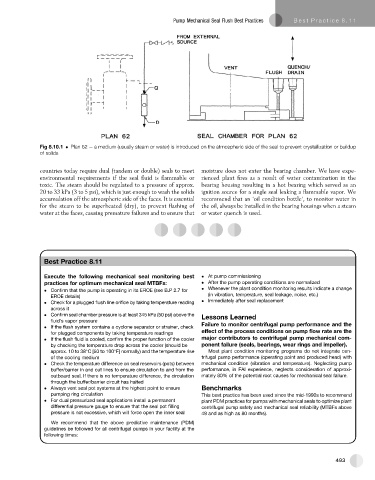Page 522 - Subyek Teknik Mesin - Forsthoffers Best Practice Handbook for Rotating Machinery by William E Forsthoffer
P. 522
Pump Mechanical Seal Flush Best Practices Best Practice 8 .11
Fig 8.10.1 Plan 62 e a medium (usually steam or water) is introduced on the atmospheric side of the seal to prevent crystallization or buildup
of solids
countries today require dual (tandem or double) seals to meet moisture does not enter the bearing chamber. We have expe-
environmental requirements if the seal fluid is flammable or rienced plant fires as a result of water contamination in the
toxic. The steam should be regulated to a pressure of approx. bearing housing resulting in a hot bearing which served as an
20 to 33 kPa (3 to 5 psi), which is just enough to wash the solids ignition source for a single seal leaking a flammable vapor. We
accumulation off the atmospheric side of the faces. It is essential recommend that an ‘oil condition bottle’, to monitor water in
for the steam to be superheated (dry), to prevent flashing of the oil, always be installed in the bearing housings when a steam
water at the faces, causing premature failures and to ensure that or water quench is used.
Best
Best Practice 8.11Practice 8.11Practice 8.11
Best
Execute the following mechanical seal monitoring best At pump commissioning
practices for optimum mechanical seal MTBFs: After the pump operating conditions are normalized
Confirm that the pump is operating in its EROE (see B.P 2.7 for Whenever the plant condition monitoring results indicate a change
EROE details) (in vibration, temperature, seal leakage, noise, etc.)
Check for a plugged flush line orifice by taking temperature reading Immediately after seal replacement
across it
Confirm seal chamber pressure is at least 345 kPa (50 psi) above the Lessons Learned
fluid’s vapor pressure
Failure to monitor centrifugal pump performance and the
If the flush system contains a cyclone separator or strainer, check
effect of the process conditions on pump flow rate are the
for plugged components by taking temperature readings
If the flush fluid is cooled, confirm the proper function of the cooler major contributors to centrifugal pump mechanical com-
by checking the temperature drop across the cooler (should be ponent failure (seals, bearings, wear rings and impeller).
approx. 10 to 38 C [50 to 100 F] normally) and the temperature rise Most plant condition monitoring programs do not integrate cen-
of the cooling medium trifugal pump performance (operating point and produced head) with
Check the temperature difference on seal reservoirs (pots) between mechanical condition (vibration and temperature). Neglecting pump
buffer/barrier in and out lines to ensure circulation to and from the performance, in FAI experience, neglects consideration of approxi-
outboard seal. If there is no temperature difference, the circulation mately 80% of the potential root causes for mechanical seal failure.
through the buffer/barrier circuit has halted
Always vent seal pot systems at the highest point to ensure Benchmarks
pumping ring circulation This best practice has been used since the mid-1990s to recommend
For dual pressurized seal applications install a permanent plant PDM practices for pumps with mechanical seals to optimize plant
differential pressure gauge to ensure that the seal pot filling centrifugal pump safety and mechanical seal reliability (MTBFs above
pressure is not excessive, which will force open the inner seal 48 and as high as 80 months).
We recommend that the above predictive maintenance (PDM)
guidelines be followed for all centrifugal pumps in your facility at the
following times:
493

